Evolving Workforces
The Math Behind the Hybrid Workplace
New Occupancy Metrics to Measure Today's Work Pattern Variations
January 11, 2024 8 Minute Read

Introduction
CBRE research indicates that 80% of current office occupiers have adopted and will sustain hybrid work policies. This systemic change in how, where and when employees work requires rebalancing existing workplaces to create an attractive in-office experience while optimizing real estate portfolios for cost savings. These ambitions are aligned under the same overarching principle: Reducing seats can create more vibrancy in the office and generate savings to reinvest in the space, technology and services to optimize the employee experience.
But how do you know how much space you need for hybrid working? In this report, CBRE’s Americas Consulting experts explore three ways hybrid work changes the math behind workplace planning.
Key Challenges and Solutions:
- Hybrid work increases the variation of attendance and show-up rates. Prevailing methods for visualizing utilization often fail to capture the nuances of these patterns and can lead to over- or under-estimating the appropriate allocation of space.
Solution: Visualizing utilization data through the lens of peak and non-peak demand increases the accuracy of future estimates for the quantity and mix of desks and supporting spaces. - Hybrid workstyles require an expanded variety of space types to support focus and virtual and in-person collaboration in the office.
Solution: Leverage micro-level utilization data to determine which types of spaces best support the desired workplace experience based on employee behaviors and preferences. - Hybrid work has encouraged a rethinking of how we measure a real estate portfolio’s effectiveness.
Solution: Revisit your occupancy metrics to understand how hybrid work patterns have changed employee behaviors.
How hybrid work changes the demand for space
At its foundation, office portfolio management is about balancing the demand and supply of space to support an organization’s business and culture goals. Historically, when employees worked in the office full-time, the demand for space was based on current and future headcount because each person was provided one workspace.
Today, the demand for hybrid workspace goes beyond headcount and is driven by a combination of workplace policy and employee work styles, which can be understood by examining office attendance and use patterns. The more flexible the hybrid work policy is, the harder it can be to predict employee behaviors, and, by extension, how much total space is needed. As a result, organizations are increasingly implementing workplace policies that offer flexibility within specific guardrails. CBRE’s 2023 U.S. Office Occupier Sentiment Survey found that 65% of survey respondents mandate some level of office attendance, while 30% leave office attendance fully up to the employee.
Setting clear expectations for the amount of time spent working in the office creates sufficient predictability for employees to maximize their in-office time and for organizations to manage building services and space supply. While office attendance and headcount forecasts help us understand the organization’s demand for space, utilization data helps us understand how effectively the existing space supply meets that demand. Organizations are also looking for new ways to visualize these metrics to help inform decision-making.
Figure 1: Current Guidance on Employer Expectations for Office Attendance
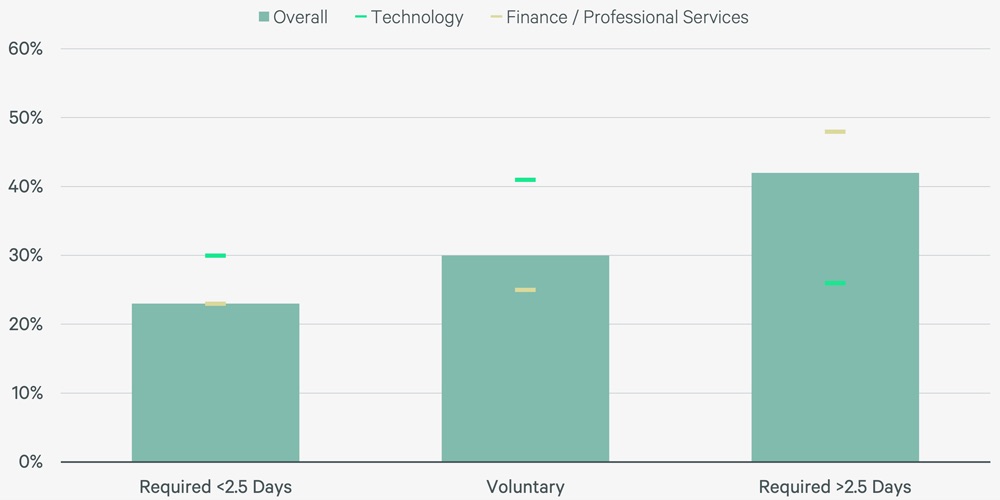
Occupancy Strategy Terms
Office Attendance: The total number of people who visit the office in a given time period.
Office Show-up Rate: A method of understanding the demand for space based on employee attendance patterns. To calculate, divide office attendance by the total headcount of the office.
Office Utilization Rate: A method of comparing space demand and supply to determine if space is being used effectively. Calculate by dividing the office attendance by the capacity of the office.

How We Visualize Office Attendance
To understand these differences, consider the visualization of utilization data itself. Figure 2 illustrates a typical pre-COVID company with an expectation of full-time on-site work. Accounting for vacation days, sick days, business travel and other behavior deviations, this work model commonly yielded a 70% average show-up rate with minimal daily variation. High show-up rates and tight clustering of the data meant that calculating space demand was straightforward. Often, charts like this were enough to understand what was going on.
Figure 2: Typical Attendance Visualization
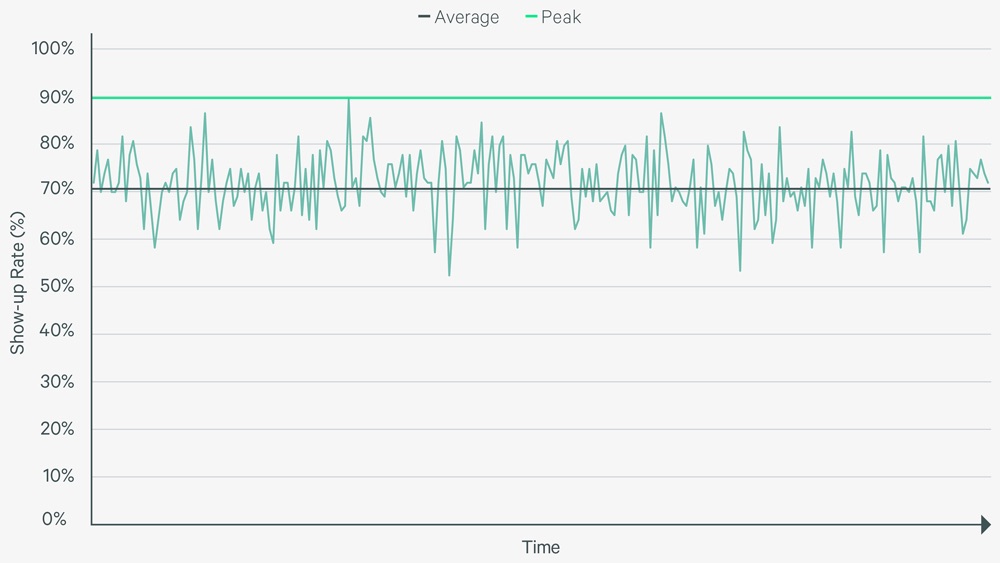
How We Visualize Office Attendance
Traditional show-up rate charts, as shown in Figure 2, display daily office attendance over time, allowing for the identification of average and peak rates. However, these visualizations do not allow for more nuanced evaluation of structure in the data including peak frequency, day of the week differences, median vs. mode rates, etc.
More flexible working patterns introduce more noise into the data, which can best be understood by disaggregating the visualization and looking at days of the week. Figure 3 illustrates how looking at attendance as a daily distribution enables us to see the structure in the data more clearly by showing the frequency of a given show-up rate rather than show-up rates over time.
Figure 3: Recommended Attendance Visualization
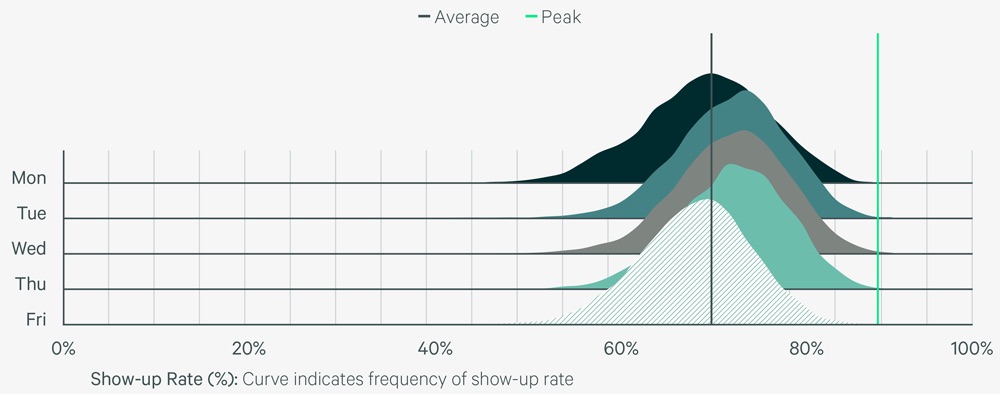
Let’s examine how differences in hybrid policies impact office attendance and the demand for space. Figure 4 represents a Full Flexibility policy that allows employees freedom to choose which days to work on-site. The popularity of Mondays and Fridays as work-from-home days often leads to increased office traffic on Tuesdays, Wednesdays and Thursdays. By contrast, Figure 5 represents a WFH Fridays policy that requires on-site work Monday through Thursday with an option to work remotely on Fridays. The WFH Fridays policy creates consistent, reliable office attendance but limits the seat-sharing opportunities that help to optimize space. The Full Flexibility policy results in lower office attendance patterns that vary across the week. When viewed with this lens, it exposes a pattern of underutilized space that can be eliminated or repurposed for cost savings. These examples reveal how hybrid work policies with more flexibility generally present greater opportunities for space contraction, as long as the data shows enough structure.
Figure 4: Full Flexibility Attendance Visualization
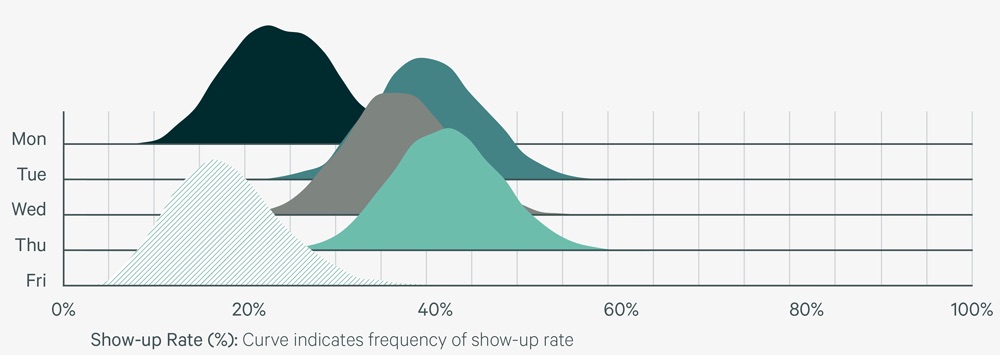
Figure 5: Work-From-Home Fridays Attendance Visualization
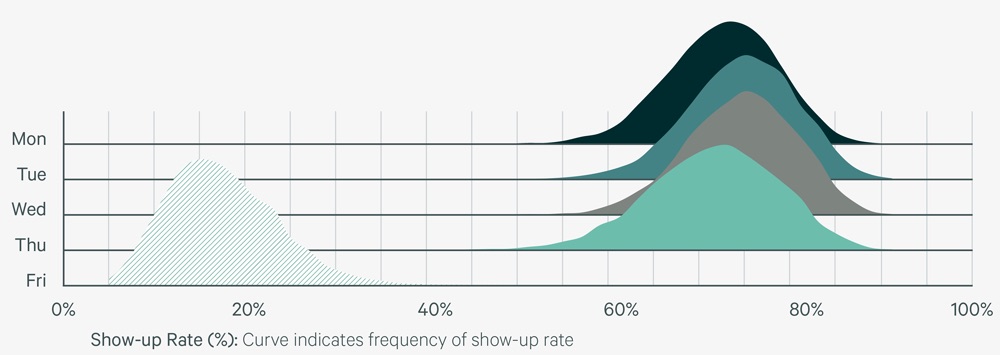
To further illustrate this concept, Figure 6a compares the potential for space reduction between two hybrid policies that both expect approximately three days per week of on-site work. The average weekly utilization rates between these two models are similar, but they differ greatly in how utilization is distributed across the week. The Core Days for All model dictates that all employees must work on-site midweek, reducing the opportunity for space-sharing since most employees are on-site at the same time. Even though the office in this example is significantly underutilized on Mondays and Fridays, the space cannot be reduced because the policy mandates high office attendance Tuesday through Thursday.
The More Flexibility policy in Figure 6b provides a much better opportunity to reduce the existing space. By allowing employees to choose which days they work on-site, this policy distributes space utilization across the week, which facilitates space-sharing. As a result, we can target a space-sharing ratio of around 1.5 people to every one seat, creating an opportunity to reduce space by approximately 20% compared to the Core Days model.
Appropriate seat-sharing also has a positive effect on how the space feels. Using these distributions, we can quantify and visualize how many days reach a vibrancy threshold—the level of fullness required to make the office feel energetic and full of life. If the same level of seat-sharing were applied to the Core Days model, the result would be too many days over capacity, leading to potentially frustrating experiences where employees cannot find a place to work.
Figure 6a: Core Days Attendance Visualization & Figure 6b: More Flexibility Attendance Visualization
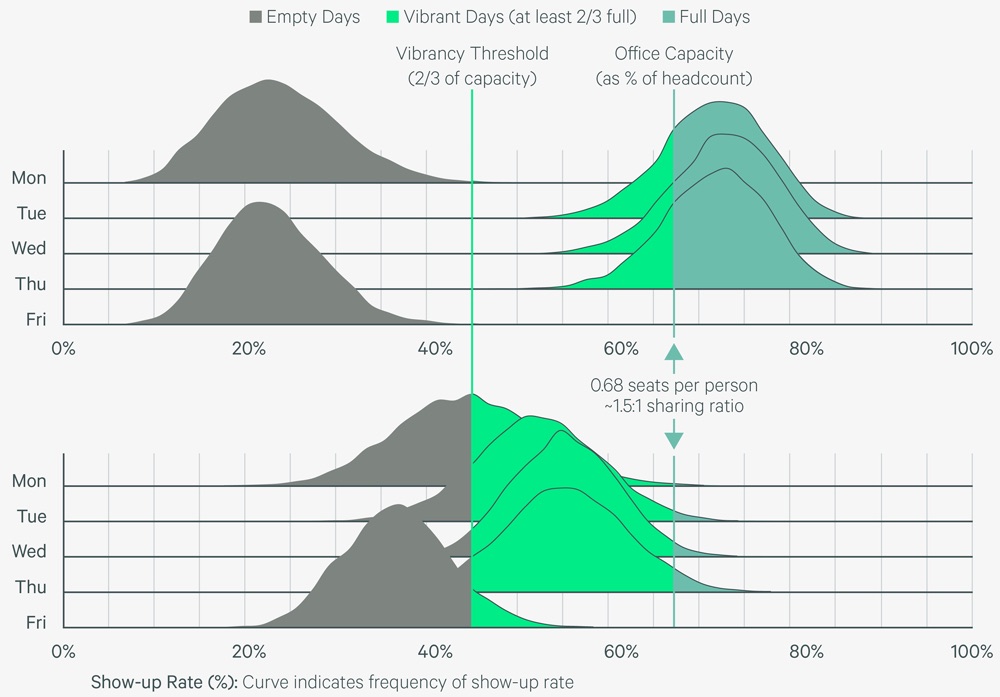
Attendance projections and capacity modelling that incorporates the concept of vibrancy can also be used to assess growth scenarios, where it may be useful to understand potential expansion dates. Figures 7a and 7b reflect the compounded impact of growth within a fixed number of seats under different scenarios, thereby illustrating the likely and predictable office experience over time. By modeling attendance as a distribution that moves with headcount, over-capacity years can be anticipated and addressed through real estate optionality.
Figure 7a: 2.5% Growth Scenario & Figure 7b: 7% Growth Scenario
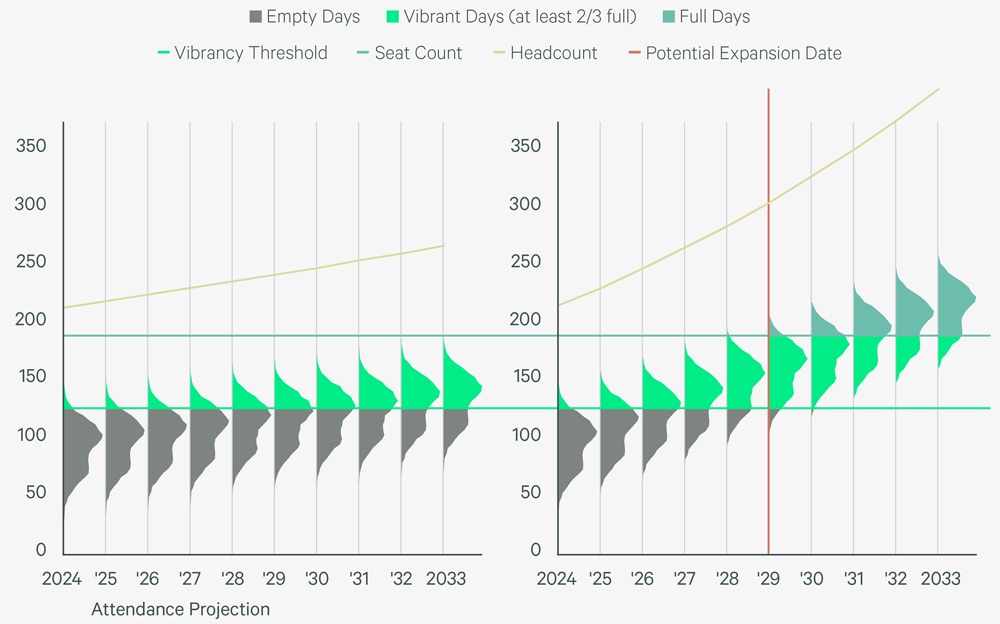
How hybrid work changes the types of space we use
Following a decision on hybrid work policy and its impact on space demand, an organization must determine what types of space best support the desired workplace experience. According to CBRE’s 2023 Office Occupier Sentiment Survey, the majority of employees surveyed go to the office for team connection and community. This preference is reflected in XYSense's recent micro-level space utilization data, which found that, on average, collaboration spaces were utilized 64% more throughout the day than desks (Workpoint Space Type).
Figure 8: Most Popular Space Types (by Utilization Hours)
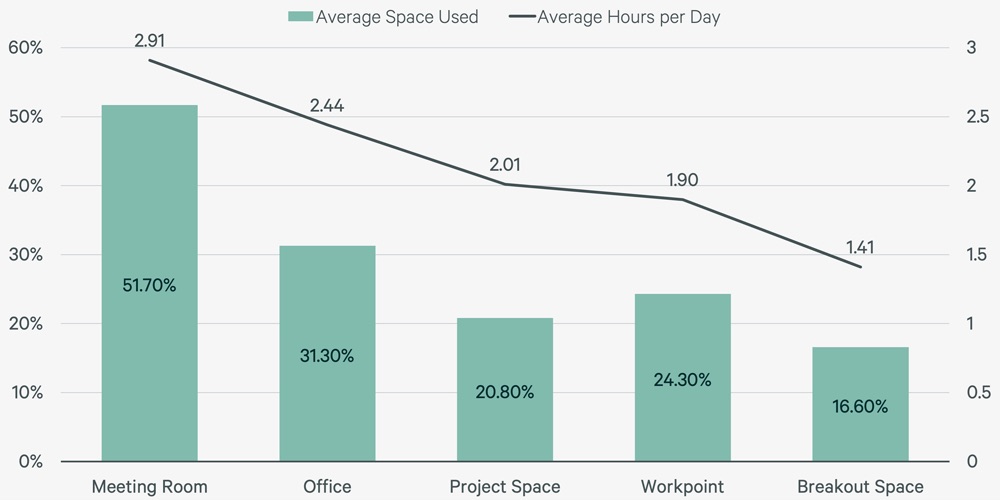
Macro and Micro Utilization Data
Macro level utilization, usually captured through security badging data, measures how efficiently space is used at the building or campus level. This data helps us understand how much space is needed to support overall attendance but is not granular enough to tell which space types are used most.
Micro level utilization, usually captured through sensors or network data, measures how efficiently individual spaces (or groups of spaces like neighborhoods, or zones) are used. This data helps us understand which space types employees prefer and can be aggregated to create macro level utilization data with a higher level of data accuracy than typical security badge swipes.

Micro level utilization patterns across different space types show a distinct pattern: Collaboration spaces are being used more often, and for longer, than individual workspaces. This underscores employees’ desire for a different mix of spaces in the office to support collaboration and new ways of working.
Activity-based working (ABW), a design philosophy that provides a variety of space types for different work tasks, is ideally suited for the hybrid workplace. In addition to providing users flexibility and choice, it allows for the practical segmentation of quiet concentration space from public socialization space. Over 53% of participants in CBRE's 2023 Global Workplace & Occupancy Insights benchmarking program selected ABW as the design concept that best represents their portfolio.
Common design elements found in activity-based working designs include:
Focus Zones: This alternative workspace gives employees a comfortable focus space for maximum concentration.
Vitamin D Zone: This alternative workspace gives employees a comfortable focus space near the windows to recharge and reset.
Coffee Bar: A coffee bar at the entry creates a vibrant and lively space for employees to gather.
Neighborhood for a day: Neighborhoods are user-defined, multi-use spaces. Division between primary workspaces and activity spaces is blurred.
Flexible Team Space: Semi-enclosed spaces for employees to collaborate on projects and ideas in a more relaxed setting.
Townhall: Multi-use gathering space to reinforce culture and allow remote and hybrid workers to connect.

Activity-based working acknowledges that different types of work benefit from different types of space. This challenges organizations to redefine their portfolio performance metrics as well as their space designs.
Offices designed for ABW are tailored to specific employee workstyles and organizational workplace policies. Workstyles can be understood by plotting how various teams work (more focused or more collaborative) and the predictability of their routine (more predictable or more spontaneous).
The allocation and utilization of space can then be mapped to these criteria. Four prototypical plans shown here represent office concept designs that balance space allocation and anticipated use to match four categorical work styles (focus and predictable, collaborative and predictable, focused and spontaneous, collaborative and spontaneous).
Across all workstyles, we are seeing a great demand for collaborative and social spaces in the office. CBRE’s 2023-2024 Global Workplace & Occupancy Insights Report found a 25% year-over-year reduction in individual work or "me" space since 2021, indicating organizations are rebalancing space to improve the onsite work experience.
Figure 9: Future of Work 2.0 Plans
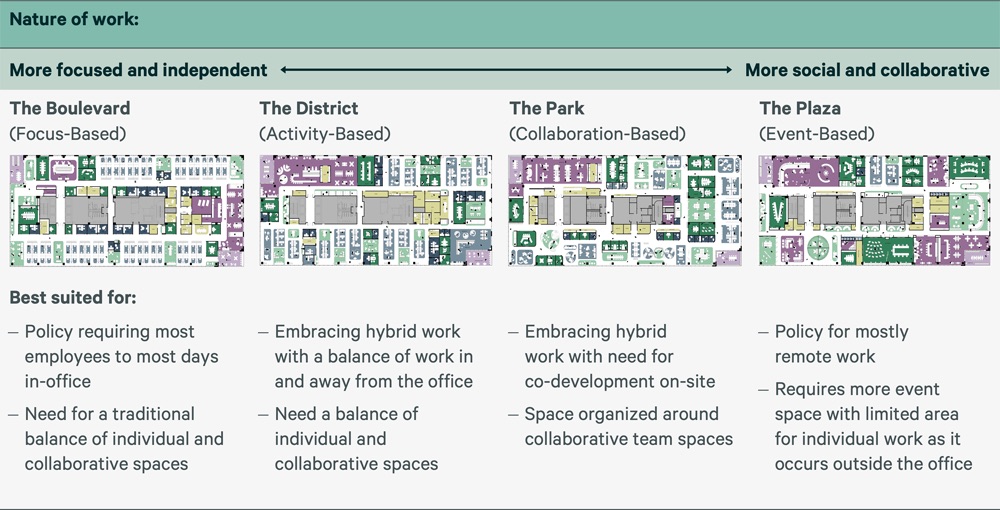
How hybrid work changes workplace occupancy metrics
The workplace is increasingly used as a competitive advantage to attract and retain talent. As a result, real estate teams are expanding their performance metrics to include employee experience, organizational dynamics, financial and ESG criteria to determine how effectively the workplace supports larger operational and cultural goals. While these advances are critical to the overall effectiveness of a workplace strategy, it’s also important to consider the impact of hybrid working on basic occupancy metrics. For example, what does your organization consider a “workspace:” is it a workstation, an enclosed office, a meeting room?
Few organizations have updated their workplace occupancy metrics to reflect new employee habits and workplace priorities. For example, consider the most basic element of workplace planning: office capacity. Traditionally, office capacity was tied to the total number of spaces designed for focus work, excluding alternative work settings such as conference rooms, huddle rooms and informal collaboration areas. Today, more and more in-office work happens in those alternative work settings.
This can lead to scenarios where workstation use is low despite high office attendance because employees leverage multiple work settings throughout the day. Counting alternative workspaces in the overall office capacity is one simple way organizations can update their portfolio performance metrics to measure the reality of hybrid working.
Let’s look at an example of how including alternative workspaces in the office capacity impacts workplace metrics and the opportunity to optimize space.

Focus-Based Layout: The Boulevard
To calculate the Math of Hybrid Work—taking into consideration the nature of work and target office show rate—varied employee populations can be planned within the same office footprint. Take for example the following layouts of a typical office floor of 25,000 square feet.
In Figure 10a, the design capacity of the office is 125. Since the layout is oriented for mostly in-office teams, you would limit the headcount to match design capacity. Assuming an average of 70% show-up rate, which mirrors pre-pandemic office attendance, and a busy-day show-up rate of 85%, 106 of the 125 seats would be in use at one time. Conference rooms and amenity spaces would be reserved to support teams working on-site.
Figure 10a: The Boulevard (Focus-Based)
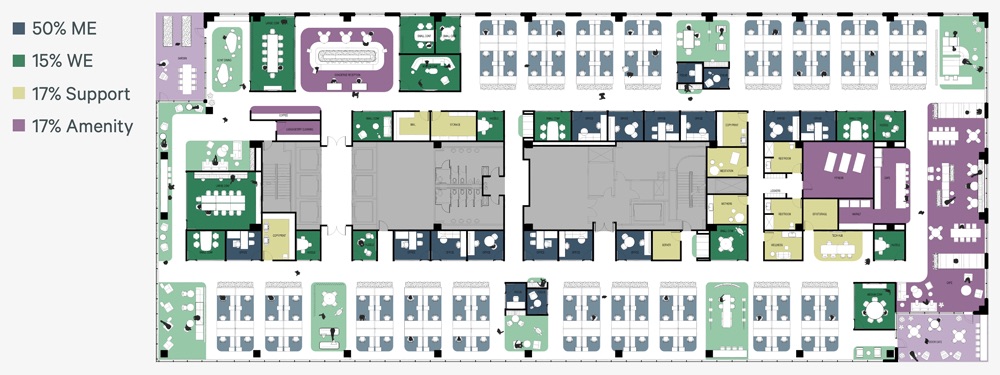
Figure 10b: The Math of Focus-Based Work

Activity-Based Layout: The District
When we look however at layouts designed for hybrid work, the opportunity to increase utilization becomes apparent as the daily office attendance varies.
Figure 11a depicts a traditional ABW layout with networks of spaces assigned to teams in distinct neighborhoods. In this example, assuming 75% busy-day show-up rate, the same footprint designed in this manner can accommodate an employee population of 155 people.
Figure 11a: The District (Activity-Based)
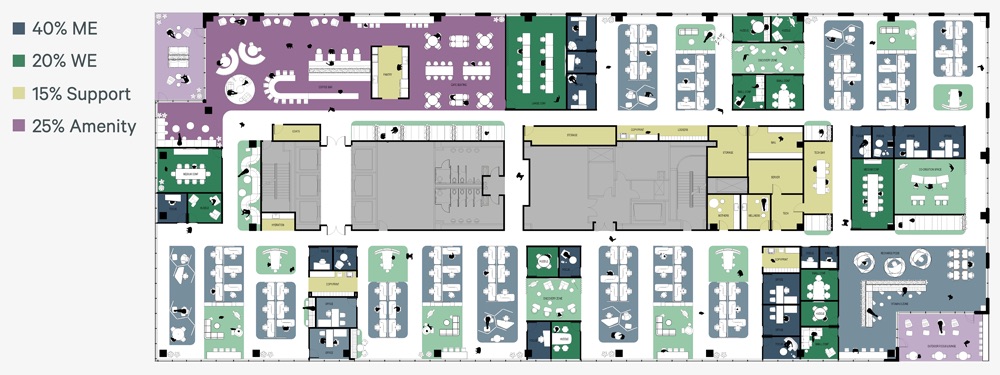
Figure 11b: The Math of Activity-Based Work

Collaboration-Based Layout: The Park
For a similar organization embracing hybrid work, but one with a slightly lower attendance model and more pronounced demand for collaborative work (often found with functions focused agile development processes), the space can be organized with more collaborative spaces designed to be utilized over a longer period of time. These “alternative” work seats increase the capacity of the space while reducing the demand for additional individual seats. This is reflected in the plan in Figure 12a.
In this example, the higher demand for conference space, used over longer durations, reduces the demand for individual seats and allows for an increase in office population, resulting in a workplace experience that is at least as vibrant as each previous model.
Figure 12a: The Park (Collaboration-Based)
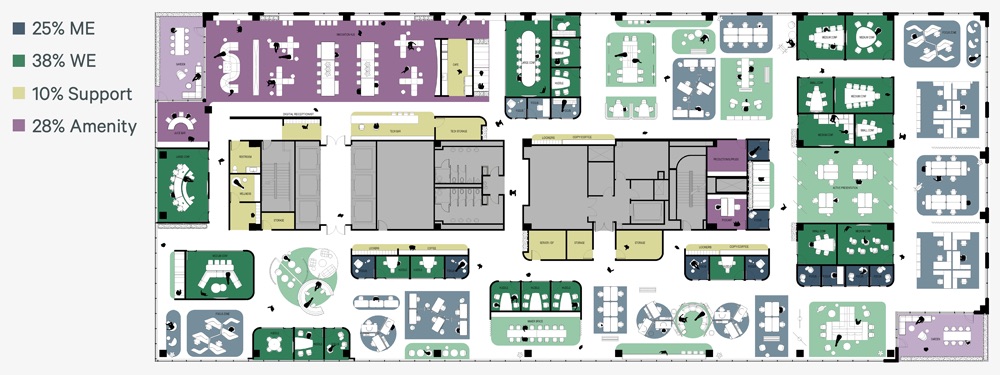
Figure 12b: The Math of Collaboration-Based Work

Event-Based Layout: The Plaza
Lastly, for an organization pursuing a more remote work-focused approach: While this % of organizations is decreasing year over year post-pandemic, it still represents 5% of CBRE clients surveyed relative to their workplace policies. For this organization, planning for the office is event based, with an emphasis on providing a platform for team meetings and company events to foster connection and engagement across a mostly distributed and work-from-home workforce. This is reflected in Figure 13a.
In this example, the target office utilization changes from being office- centric to what would be more appropriate for a conference center facility (from 65% to 40%). Here the headcount can scale significantly based upon the frequency of on-site events planned.
Figure 13a: The Plaza (Event-Based)
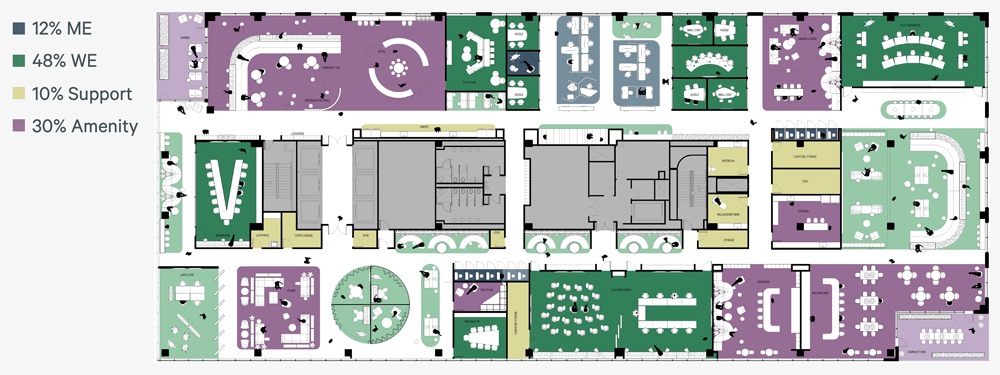
Figure 13b: The Math for Event-Based Work

Conclusion
Determining how much space you need for hybrid work is a multi-variable process that includes three high-level steps:
- Understand the demand for space by analyzing office attendance and space utilization patterns,
- Leverage micro-level utilization data to determine which types of spaces best support the desired workplace experience activities, and
- Revisit your portfolio performance metrics to ensure they measure hybrid work patterns.
Hybrid work commonly offers space optimization opportunities that can yield between 10% and 50% space savings. Understanding how hybrid work has impacted the demand for space and your performance metrics is the first step in unlocking portfolio efficiency and cost savings.
To better understand how you can maximize your future workplace planning efforts, please contact Americas Consulting.
Hybrid work commonly offers space optimization opportunities that can yield between 10% and 50% space savings.

Related Insights
Related Services
Leverage occupancy data to empower, anticipate and unlock opportunities within your portfolio.
Build resilience, attract and retain talent, and foster connection and collaboration in your workplace.
- Transform Business Outcomes
Consulting
Gain comprehensive guidance on insightful, executable real estate strategies for both investors and occupiers.
Contacts
Susan Wasmund
Executive Managing Director, Americas Consulting | Global Occupancy Management






